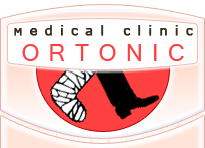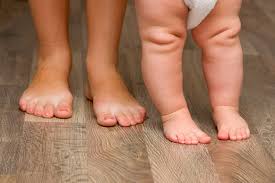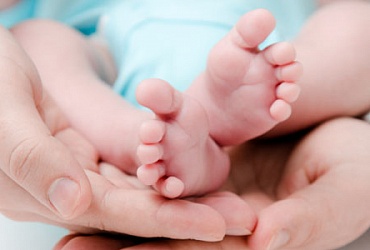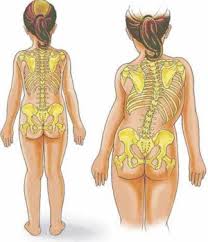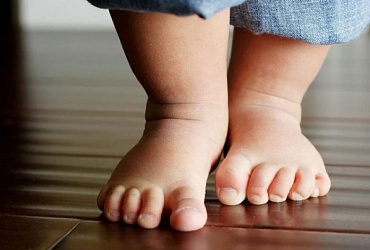Osgood-Schlatter Disease

Osgood-Schlatter Disease
Osgood-Schlatter disease can manifest as a painful bump in the area below the patella in childhood and adolescence, when the period of puberty begins. Osgood-Schlatter disease occurs often in children who go in for sports, especially such as jogging, jumping, or sports that require rapid changes in trajectory such as football, basketball, figure skating and gymnastics.
Symptoms
The main symptoms of Osgood-Schlatter disease include:
Pain, swelling, and tenderness in the region of tibial tuberosity, just below the kneecap, pain in the knees that increase after physical activity, especially when running, jumping and climbing the stairs-and the tension of surrounding muscles, especially the thigh muscles (the quadriceps muscles)
Pain varies depending on each individual. Some can have only mild pain when performing certain activities, especially when running or jumping. In others, pain can be permanent and debilitating. As a rule, Osgood-Schlatter disease develops only in one knee, but sometimes it can occur in both laps. Discomfort can last from a few weeks to several months and can be repeated until the child ceases to grow.
Causes
In each tubular bone of the child (in the arm or leg) there are growth zones, at the end of the bones are their cartilage. Cartilaginous tissue is not as strong as bone and therefore more prone to damage and excessive loads on the growth zones can lead to swelling and painfulness of this zone. During physical activity, where there is a lot of running, jumping and sloping (football, basketball, volleyball and ballet), the muscles of the thigh in the child stretch the tendon - the quadriceps muscle that connects the knee cap to the tibia.
Such repetitive loads can lead to slight tearing of the tendon from the tibia, which results in the appearance of swelling and pain, characteristic of Osgood-Schlatter disease. In some cases, the child's body tries to close this defect with the growth of bone tissue, which leads to the formation of bone cones.
To diagnose the Osgood-Schlatter disease, the doctor will examine the knee joint of the child, which will determine the presence of edema, tenderness, redness. In addition, the volume of movements in the knee and thigh will be assessed. Of the instrumental methods of diagnosis, radiography of the knee and shin is most often used, which makes it possible to visualize the attachment of the patellar tendon to the tibia.
Treatment
Osgood-Schlatter disease can manifest as a painful bump in the area below the patella in childhood and adolescence, when the period of puberty begins. Osgood-Schlatter disease occurs often in children who go in for sports, especially such as jogging, jumping, or sports that require rapid changes in trajectory such as football, basketball, figure skating and gymnastics.
Symptoms
The main symptoms of Osgood-Schlatter disease include:
Pain, swelling, and tenderness in the region of tibial tuberosity, just below the kneecap, pain in the knees that increase after physical activity, especially when running, jumping and climbing the stairs-and the tension of surrounding muscles, especially the thigh muscles (the quadriceps muscles)
Pain varies depending on each individual. Some can have only mild pain when performing certain activities, especially when running or jumping. In others, pain can be permanent and debilitating. As a rule, Osgood-Schlatter disease develops only in one knee, but sometimes it can occur in both laps. Discomfort can last from a few weeks to several months and can be repeated until the child ceases to grow.
Causes
In each tubular bone of the child (in the arm or leg) there are growth zones, at the end of the bones are their cartilage. Cartilaginous tissue is not as strong as bone and therefore more prone to damage and excessive loads on the growth zones can lead to swelling and painfulness of this zone. During physical activity, where there is a lot of running, jumping and sloping (football, basketball, volleyball and ballet), the muscles of the thigh in the child stretch the tendon - the quadriceps muscle that connects the knee cap to the tibia.
Such repetitive loads can lead to slight tearing of the tendon from the tibia, which results in the appearance of swelling and pain, characteristic of Osgood-Schlatter disease. In some cases, the child's body tries to close this defect with the growth of bone tissue, which leads to the formation of bone cones.
To diagnose the Osgood-Schlatter disease, the doctor will examine the knee joint of the child, which will determine the presence of edema, tenderness, redness. In addition, the volume of movements in the knee and thigh will be assessed. Of the instrumental methods of diagnosis, radiography of the knee and shin is most often used, which makes it possible to visualize the attachment of the patellar tendon to the tibia.
Treatment
Usually Osgood-Schlatter's disease is cured independently, and the symptoms disappear after the growth of bones. If the symptomatology is expressed, then the treatment includes medication, physical therapy, exercise therapy.
